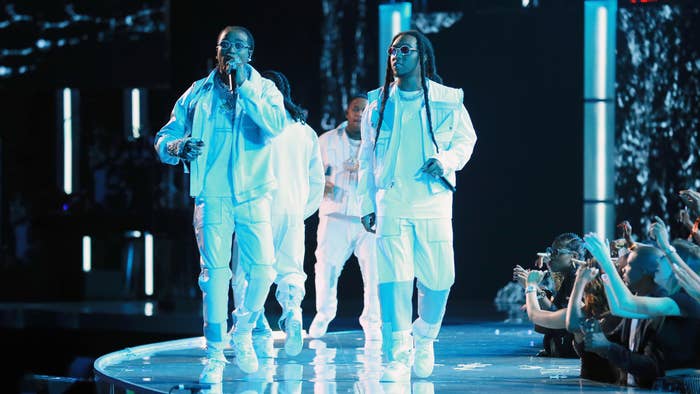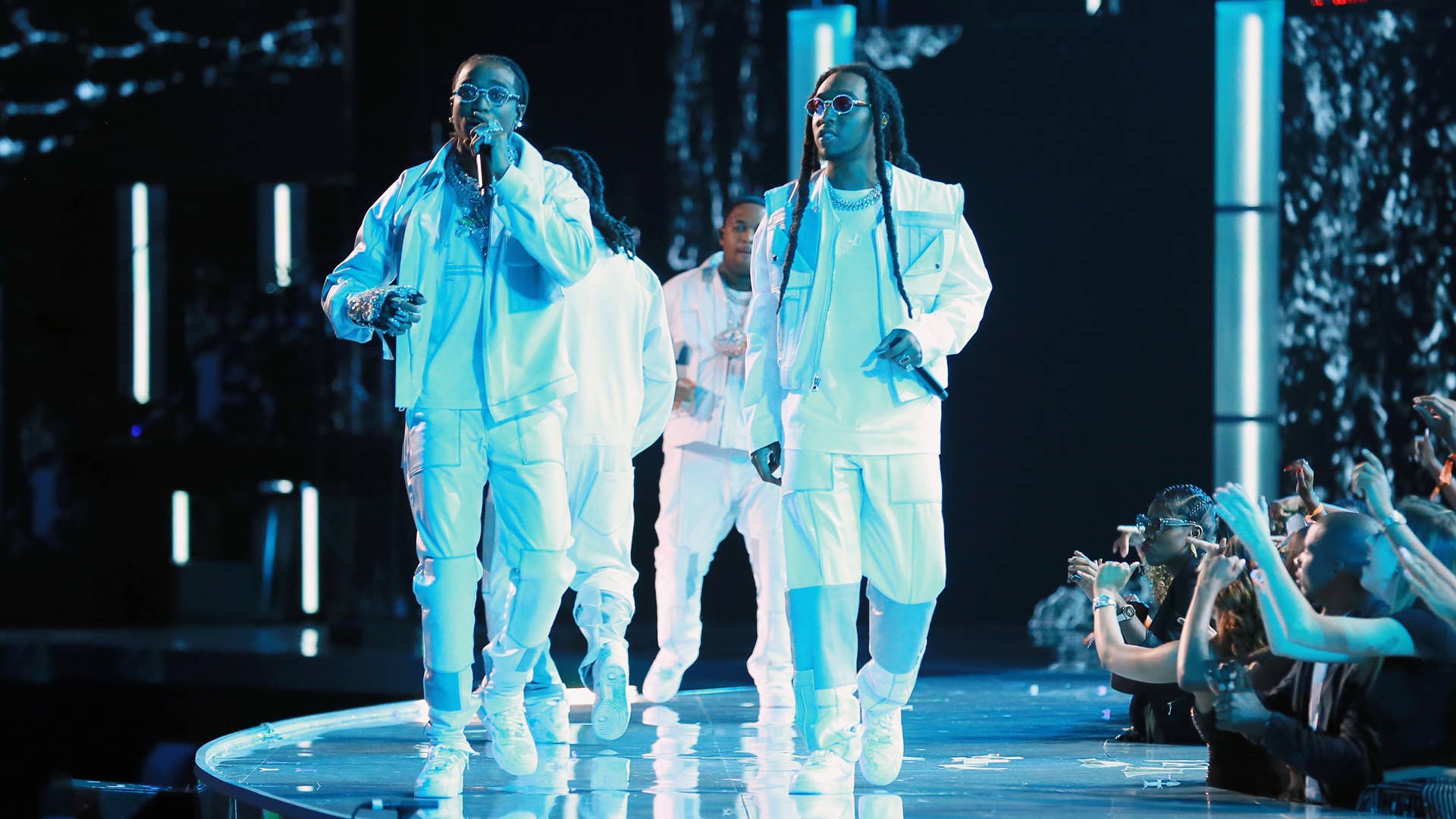
On the week of June 28, three out of the top five albums on the Billboard 200 had a duration of 50 minutes or more. Polo G’s Hall of Fame has a total of 20 songs, clocking in at 54 minutes; Migos’ Culture III has 19 tracks and runs for one hour and 15 minutes; and Lil Baby and Lil Durk’s joint project The Voice of the Heroes runs for one hour with 18 tracks. This isn’t a new phenomenon, either. In the streaming era, there are no physical limitations on the length of an album, and it’s become common for tracklists to reach or exceed 20 songs.
For years, fans have complained about long albums, and yet artists keep releasing 20-plus-track projects. Minimalism is taking over the fashion and architecture industries, but it seems to have skipped the music industry. So, if less is more everywhere else, why are albums getting longer?
For artists, there are obvious benefits in putting out an extended body of work—more songs usually means more streams. For fans, though, consuming an excessive amount of music from the same artist in one sitting is often tedious and doesn’t make for a great listening experience. The longer a tracklist gets, the more likely there will be redundancies and songs that should have been left on the cutting room floor.
If you ask any rap fan about long albums over the past five years, there are a few examples that will be mentioned more than others. In 2016, Drake released Views, a 20-song album with a runtime of one hour and 21 minutes (naturally, it broke streaming records at the time). In 2017, Chris Brown dropped his 45-track album Heartbreak on a Full Moon, which clocked in at two hours and 38 minutes. In January 2018, the Migos followed with Culture II, a 24-track album that ran for an hour and 45 minutes. Then, six months later, Drake dropped his 25-track project Scorpion. The LP was intended to be a double disc, and the project ran for one hour and 30 minutes.
According toRolling Stone, the duration of the top five streamed albums on Spotify rose almost 10 minutes between 2013 and 2018, to an average of 60 minutes. Although, as Pitchfork points out, there were times in the late ‘‘90s and early 2000s when the average rap album was even longer than it is now. But double albums like OutKast’s Speakerboxxx/The Love Below or Dipset’s Diplomatic Immunity were the result of calculated decisions in an era of physical production costs, whereas long albums in today’s streaming era often lack artistic intention.
It’s worth noting that artists, especially in hip-hop, are always sitting on a lot of unreleased music. Migos collaborators have gone on record stating that they can make songs in under 20 minutes, and artists often have dozens of songs in the vault, waiting to be released. Even so, the decision to bulk up albums seems to be driven more from a commercial standpoint, rather than a desire to “feed the fans.” When Billboard and the Recording Industry Association of America (RIAA) began incorporating streaming numbers in chart and certifications calculations, it gave artists an incentive to bulk up their albums. The longer the album, the more likely it is to generate streams, which can lead to a higher ranking on Billboard or a platinum plaque. Both Migos and Drake debuted at No. 1 on the Billboard 200 in 2018, while Chris Brown’s lengthy album debuted at No. 3. This strategy is even more important right now, after the COVID-19 pandemic put a strain on yearly income and left artists looking for ways to make up for touring revenue.
Joey Badass once told Complex that a good album should have no more than 14 songs, with the duration likely varying between 30 to 45 minutes: “I don’t care if it was Michael Jackson, I am not listening to 25 songs. Less is more in my opinion.”
Financial benefits aside, though, stacking albums doesn’t take into consideration how music consumption has changed over the last few years. According to database company Statista, 54 percent of global consumers listen to fewer albums than they did five or 10 years ago. A 2019 survey conducted by Deezer in the UK, revealed that 15 percent of music fans under the age of 25 have never listened to a full album. Forty-two percent of those listeners are putting their favorite tracks on shuffle or playing them individually. Sure, adding more songs to a tracklist improves the chances that they’ll be added to playlists, but it damages the overall listening experience for a generation that’s moving away from listening to albums anyway. And in the streaming era, fans are receiving more music than ever before. Gone are the days of buying a couple albums at the record store and listening to them repeatedly for months. Today, fans have access to dozens of new albums every Friday, so it can become increasingly tiresome to shuffle through 20-song albums each music cycle.
Tracklists with 18 or more songs often cause fatigue for listeners. By the time you make it to the second half of these albums, they start sounding monotonous and stacked with filler tracks. Migos have fallen victim to this criticism. Following Culture III’s release, fans complained that the second half of the album sounded redundant and could have benefited from shortening the tracklist by three or four tracks. There were similar complaints about Culture II. These long tracklists also don’t cater to the way people actually listen to music. Very seldomly do you sit in one place while consuming an album. You’re usually on the train, in the car, or completing other day-to-day tasks, often making it difficult to listen to the same album for more than 30 minutes.
So, what is the ideal album length? Joey Badass once told Complex that a good album should have no more than 14 songs, with the duration likely varying between 30 to 45 minutes. “I don’t care if it was Michael Jackson, I am not listening to 25 songs. Less is more in my opinion,” he said.
The deluxe album trend could be a more effective way of releasing large quantities of music. Many artists, including Lil Baby, DaBaby, and the Weeknd dropped deluxe albums in 2020, which included five to 10 extra tracks each. The bonus tracks were listed under the album on streaming platforms, but were dropped weeks after the original release. The deluxe method gives listeners a break to digest music at a slower pace, which reduces the likelihood of exhaustion (although, of course, there will still be complaints from some fans about receiving too much music).
Lil Uzi Vert offered a slightly different approach, and was rewarded with great results. In March 2020, he released Eternal Atake, followed by Lil Uzi Vert vs. the World 2 one week later. The second release was marketed as a deluxe album, but it was actually a whole other body of work with 18 tracks. The album performed well amongst listeners, hitting the top of the Billboard 200, selling 247,000 album units in its first week.
Meanwhile, getting ready to release his next studio album, Drake dropped Dark Lane Demo Tapes in 2020. The 14-track mixtape included both pre-released and new songs, as a way to hold over fans until the new album drops and share extra material that would have ballooned its tracklist. Lil Uzi Vert and Drake’s approach is reminiscent of the early mixtape days in rap, when an artist released several projects within a short period of time. Though this method can also become tiresome, it is much easier to digest two shorter projects than one long one.
Ultimately, the ideal scenario would be for an artist to choose quality over quantity. Understandably, artists want to feed fans with a surplus of music, but sometimes it’s better to cherry pick the best songs and narrow it down to a concise tracklist. Artists will always run into insatiables fans who aren’t satisfied with just a handful of songs, but a shorter album with no skips gives them a higher chance of achieving “classic album” status. Vince Staples just released a 10-song album, which received positive responses from fans and critics alike, who praised its brevity.
Sure, it might sound ungrateful as a fan to ask that our favorite artists stop bombarding us with so much music all at once, especially after the lull we experienced in the industry in 2020. But it’s not because we’re uninterested. In fact, Spotify currently has 345 million monthly active users, which is a 27 percent increase from the previous year, according to the platform’s recent report. We’re simply looking for an easier way to digest music without being overwhelmed with an hour-long project. If artists genuinely take into consideration what their fans think, they would be wise to reconsider the long album format.

